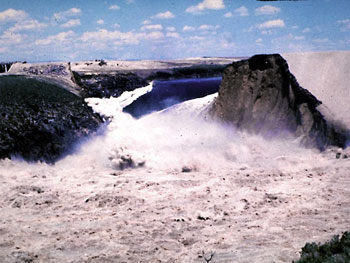
Figure One: Tenton Dam; Idaho, USA; Dam Failure, June 1976
Erosion has the ability to decay the roots of trees on the surrounding embankment of the reservoir, which can lead to a leak in the dam, or the tree can be blown over and effect the underground piping network, possibly leading to dam failure. Besides aiding in deforestation, surface erosion causes flooding to be more prevalent, which has the potential to trigger landslides. When water levels are already high in a reservoir, as a result of copious amounts of rain, a landslide has the potential of offsetting the water equilibrium, causing a slipover of the dam (Woodward). Additionally, if the reservoir reaches its capacity and the surrounding environmental structure of the dam is not sound the dam could collapse as seen on June 5th 1976 by the Teton Dam (refer to Figure One).
Earthquakes and mega dams are interrelated, each being able to trigger the other. Earthquakes can easily cause a dam to fail by offsetting a dam's base as a result in the shifting of its base or, if the dam is an arch dam an earthquake can disturb the canyon that the dam is anchored, causing its collapse. Mega dams can also trigger earthquakes. When filling a reservoir associated with a mega dam additional tons of pressure is put on the plates below the body of water which can cause them to shift, triggering an earthquake. Although not scientifically understood, this phenomenon has been proven to occur at least ninety times worldwide (Probe International), in which an earthquake and or seismic activity increases after the filling of a reservoir.
Mega dam failures send thousands of tons of water, concrete, and other hazardous materials downstream and into the surrounding ecosystem, seriously impacting downstream ecosystems.